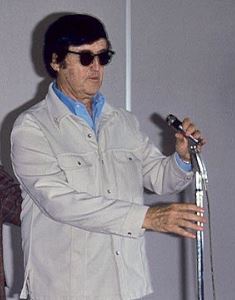|
Get Rich Quick Porky
Get Rich Quick Porky is a 1937 Warner Bros. '' Looney Tunes'' cartoon directed by Bob Clampett. The short was released on August 28, 1937, and stars Porky Pig. Chuck Jones, later to be famed as a director, is credited as animator on the short. This cartoon marks the final appearance of Gabby Goat until New Looney Tunes. The short's working title was ''The Oily Bird gets Porky''.https://cartoonresearch.com/wp-content/uploads/2015/03/Get+Rich+Quick+PorkyDraft-1.jpg Summary The title screen changes seamlessly into a sign reading: "Get Rich Quick", followed by "For Sale/This lovely lot containing lots and lots/Oh!--Just oodles of OIL!" An oil tanker pulls into the lot, and the lot's owner, dogface con artist John Gusher, hooks the tanker to a sprinkler system to make it appear as if the land is saturated with natural crude oil, in hopes of luring some suckers to buy the otherwise worthless land. Out of the corner of his eye, he spies Porky Pig and Gabby Goat ascending the steps ... [...More Info...] [...Related Items...] OR: [Wikipedia] [Google] [Baidu] |
Bob Clampett
Robert Emerson Clampett Sr. (May 8, 1913 – May 2, 1984) was an American animator, director, producer and puppeteer. He was best known for his work on the '' Looney Tunes'' animated series from Warner Bros. as well as the television shows ''Time for Beany'' and ''Beany and Cecil''. He was born and raised not far from Hollywood and, early in life, showed an interest in animation and puppetry. After leaving high school a few months shy of graduating in 1931, he joined the team at Harman-Ising Productions and began working on the studio's newest short subjects, ''Looney Tunes'' and '' Merrie Melodies''. Clampett was promoted to a directorial position in 1937. During his 15 years at the studio, he directed 84 cartoons later deemed classic, and designed some of the studio's most famous characters, including Porky Pig, Daffy Duck and Tweety. Among his most acclaimed films are ''Porky in Wackyland'' (1938) and ''The Great Piggy Bank Robbery'' (1946). He left Warner Bros. Cartoons ... [...More Info...] [...Related Items...] OR: [Wikipedia] [Google] [Baidu] |
Looney Tunes
''Looney Tunes'' is an American Animated cartoon, animated comedy short film series produced by Warner Bros. starting from 1930 to 1969, concurrently with its partner series ''Merrie Melodies'', during the golden age of American animation.Looney Tunes . ''www.bcdb.com'', April 12, 2012 Then some new cartoons were produced from the late 1980s to the mid 2010s as well as other made productions beginning in 1972. The two series introduced a large List of Looney Tunes and Merrie Melodies characters, cast of characters, including Bugs Bunny, Daffy Duck, and Porky Pig. The term ''Looney Tunes'' has since been expanded to also refer to the characters themselves. ''Looney Tunes'' and ''Merrie Melodies'' were initially produced by Leon Schlesinger and animators Harman and Ising, Hugh Harman and Rudolph Ising from 1930 to 1933. [...More Info...] [...Related Items...] OR: [Wikipedia] [Google] [Baidu] |
Magic Trick
Magic, which encompasses the subgenres of illusion, stage magic, and close up magic, among others, is a performing art in which audiences are entertained by tricks, effects, or illusions of seemingly impossible feats, using natural means. It is to be distinguished from paranormal magic which are effects claimed to be created through supernatural means. It is one of the oldest performing arts in the world. Modern entertainment magic, as pioneered by 19th-century magician Jean-Eugène Robert-Houdin, has become a popular theatrical art form. In the late 19th and early 20th centuries, magicians such as Maskelyne and Devant, Howard Thurston, Harry Kellar, and Harry Houdini achieved widespread commercial success during what has become known as "the Golden Age of Magic." During this period, performance magic became a staple of Broadway theatre, vaudeville, and music halls. Magic retained its popularity in the television age, with magicians such as Paul Daniels, David Copperfield, ... [...More Info...] [...Related Items...] OR: [Wikipedia] [Google] [Baidu] |
The Merry-Go-Round Broke Down
"The Merry-Go-Round Broke Down" is a song written in 1937 by Cliff Friend and Dave Franklin and published by Harms Inc., New York. It is best known as the theme tune for the ''Looney Tunes'' cartoon series and ''Merrie Melodies'' reissued cartoon series produced by Warner Bros. Cartoons, used from 1937 to 1969. The original version contains an introductory verse that leads up to the main part of the song, as a young man tells of his date with a young woman, in which they go to an amusement park and find time to "spark" while riding the malfunctioning carousel. The name was a play on "breakdown" and the tune is similar to the traditional " Chinese Breakdown" as well as the children's rhyme " Miss Susie had a steamboat". ''Merrie Melodies'' and ''Looney Tunes'' The tune first appeared in the ''Merrie Melodies'' cartoon short '' Sweet Sioux'', released June 26, 1937. Starting with the ''Looney Tunes'' cartoon short ''Rover's Rival'' released October 9, 1937, an adapted instrumenta ... [...More Info...] [...Related Items...] OR: [Wikipedia] [Google] [Baidu] |
Jackhammer
A jackhammer (pneumatic drill or demolition hammer in British English) is a pneumatic or electro-mechanical tool that combines a hammer directly with a chisel. It was invented by William Mcreavy, who then sold the patent to Charles Brady King. Hand-held jackhammers are generally powered by compressed air, but some are also powered by electric motors. Larger jackhammers, such as rig-mounted hammers used on construction machinery, are usually hydraulically powered. These tools are typically used to break up rock, pavement, and concrete. A jackhammer operates by driving an ''internal'' hammer up and down. The hammer is first driven down to strike the chisel and then back up to return the hammer to the original position to repeat the cycle. The effectiveness of the jackhammer is dependent on how much force is applied to the tool. It is generally used like a hammer to break the hard surface or rock in construction works and it is not considered under earth moving equipment, along ... [...More Info...] [...Related Items...] OR: [Wikipedia] [Google] [Baidu] |
Business Card
Business cards are cards bearing business information about a company or individual. They are shared during formal introductions as a convenience and a memory aid. A business card typically includes the giver's name, company or business affiliation (usually with a logo) and contact information such as street addresses, telephone number(s), fax number, e-mail addresses and website. Before the advent of electronic communication business cards might also include telex details. Now they may include social media addresses such as Facebook, LinkedIn and Twitter. Traditionally, many cards were simple black text on white stock, and the distinctive look and feel of cards printed from an engraved plate was a desirable sign of professionalism. In the late 20th century, technological advances drove changes in style, and today a professional business card will often include one or more aspects of striking visual design. Prior to the COVID-19 pandemic, approximately 7 billion business car ... [...More Info...] [...Related Items...] OR: [Wikipedia] [Google] [Baidu] |
Interest
In finance and economics, interest is payment from a borrower or deposit-taking financial institution to a lender or depositor of an amount above repayment of the principal sum (that is, the amount borrowed), at a particular rate. It is distinct from a fee which the borrower may pay the lender or some third party. It is also distinct from dividend which is paid by a company to its shareholders (owners) from its profit or reserve, but not at a particular rate decided beforehand, rather on a pro rata basis as a share in the reward gained by risk taking entrepreneurs when the revenue earned exceeds the total costs. For example, a customer would usually pay interest to borrow from a bank, so they pay the bank an amount which is more than the amount they borrowed; or a customer may earn interest on their savings, and so they may withdraw more than they originally deposited. In the case of savings, the customer is the lender, and the bank plays the role of the borrower. Interest diff ... [...More Info...] [...Related Items...] OR: [Wikipedia] [Google] [Baidu] |
Great Depression
The Great Depression (19291939) was an economic shock that impacted most countries across the world. It was a period of economic depression that became evident after a major fall in stock prices in the United States. The economic contagion began around September and led to the Wall Street stock market crash of October 24 (Black Thursday). It was the longest, deepest, and most widespread depression of the 20th century. Between 1929 and 1932, worldwide gross domestic product (GDP) fell by an estimated 15%. By comparison, worldwide GDP fell by less than 1% from 2008 to 2009 during the Great Recession. Some economies started to recover by the mid-1930s. However, in many countries, the negative effects of the Great Depression lasted until the beginning of World War II. Devastating effects were seen in both rich and poor countries with falling personal income, prices, tax revenues, and profits. International trade fell by more than 50%, unemployment in the U.S. rose to 23% and ... [...More Info...] [...Related Items...] OR: [Wikipedia] [Google] [Baidu] |
Money
Money is any item or verifiable record that is generally accepted as payment for goods and services and repayment of debts, such as taxes, in a particular country or socio-economic context. The primary functions which distinguish money are as a medium of exchange, a unit of account, a store of value and sometimes, a standard of deferred payment. Money was historically an emergent market phenomenon that possess intrinsic value as a commodity; nearly all contemporary money systems are based on unbacked fiat money without use value. Its value is consequently derived by social convention, having been declared by a government or regulatory entity to be legal tender; that is, it must be accepted as a form of payment within the boundaries of the country, for "all debts, public and private", in the case of the United States dollar. Contexts which erode public confidence, such as the circulation of counterfeit money or domestic hyperinflation, can cause good money to lose its value. ... [...More Info...] [...Related Items...] OR: [Wikipedia] [Google] [Baidu] |
Salting (confidence Trick)
In mineral exploration, salting is the process of adding a valuable metal, especially gold or silver, to a sample to change the value of the sample with intent to deceive potential buyers of the mine. Examples are the diamond hoax of 1872 and the former Canadian gold company Bre-X. Salting is an example of a confidence trick. See also *Land patent *Mining *Youngberg, Arizona *Goldfield, Arizona *Highland Park, Yavapai County, Arizona *Mineral rights Mineral rights are property rights to exploit an area for the minerals it harbors. Mineral rights can be separate from property ownership (see Split estate). Mineral rights can refer to sedentary minerals that do not move below the Earth's surfac ... References Confidence tricks Mineral exploration {{mining-stub ... [...More Info...] [...Related Items...] OR: [Wikipedia] [Google] [Baidu] |
Irrigation Sprinkler
An irrigation sprinkler (also known as a water sprinkler or simply a sprinkler) is a device used to irrigate (water) agricultural crops, lawns, landscapes, golf courses, and other areas. They are also used for cooling and for the control of airborne dust. Sprinkler irrigation is the method of applying water in a controlled manner in way similar to rainfall. The water is distributed through a network that may consist of pumps, valves, pipes, and sprinklers. Irrigation sprinklers can be used for residential, industrial, and agricultural usage. It is useful on uneven land where sufficient water is not available as well as on sandy soil. The perpendicular pipes, having rotating nozzles on top, are joined to the main pipeline at regular intervals. When water is pressurized through the main pipe it escapes from the rotating nozzles. It gets sprinkled on the crop. In sprinkler or overhead irrigation, water is piped to one more central locations within the field and distributed by overhe ... [...More Info...] [...Related Items...] OR: [Wikipedia] [Google] [Baidu] |
Dogfaces (comics)
Dogfaces is the term used by fans to designate the anthropomorphic characters and extras in comic books, comic strips, and animated cartoons. Dogfaces usually resemble cartoon human beings, but with some special characteristics: * They have four digits on each hand and as few as three toes on each foot. * They have the round black noses typical of dogs (in one ''Mickey Mouse'' comic strip, the statue of a Middle East ruler had a nose that was a giant black pearl). * They have ears that are either pointed or droopy, like a dog's. * They often have a prominent overbite. The most famous dogface is probably Goofy. Bill Farmer, an actor who voices Goofy in cartoons, suggested that Goofy is "the missing link between dog and man." Cartoonist Don Rosa apologized, tongue-in-cheek, for turning Theodore Roosevelt into a dogface for the sake of consistency in the biography of Scrooge McDuck Scrooge McDuck is a cartoon character created in 1947 by Carl Barks for The Walt Disney Co ... [...More Info...] [...Related Items...] OR: [Wikipedia] [Google] [Baidu] |







